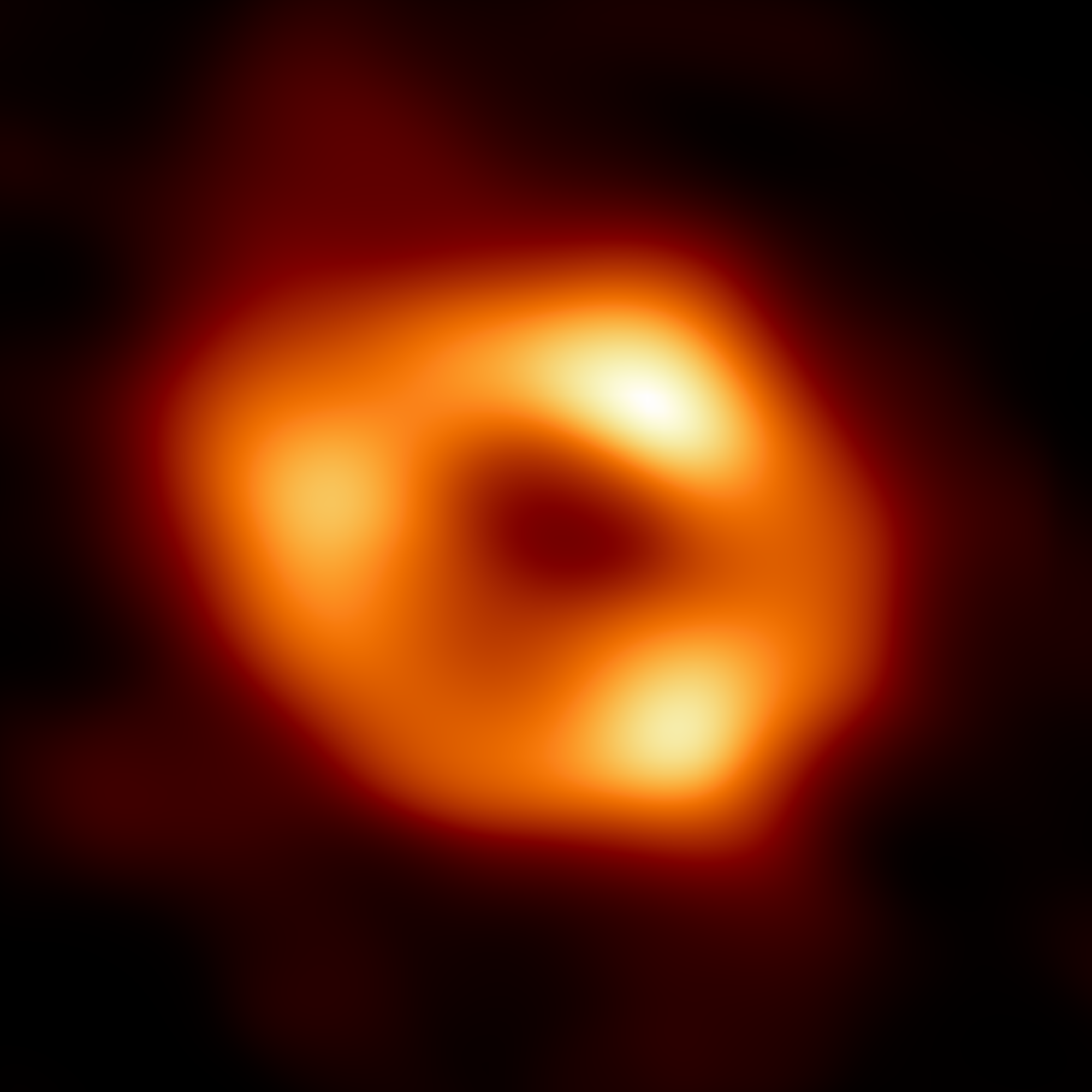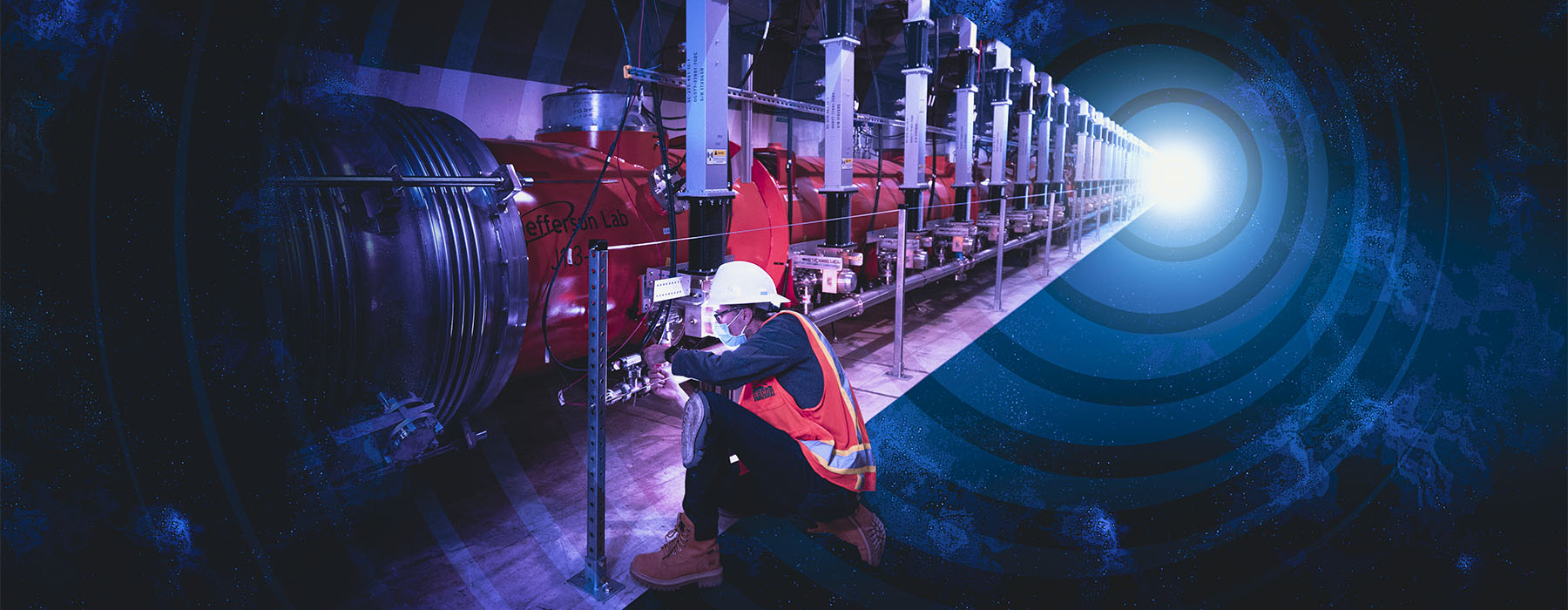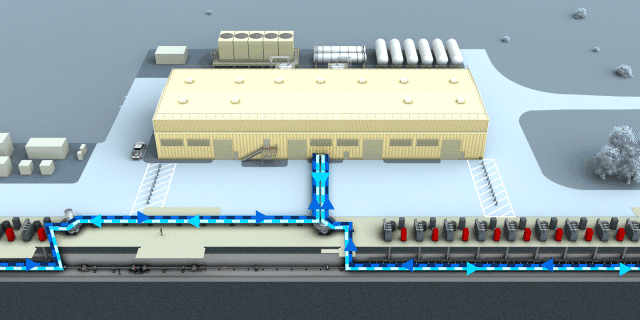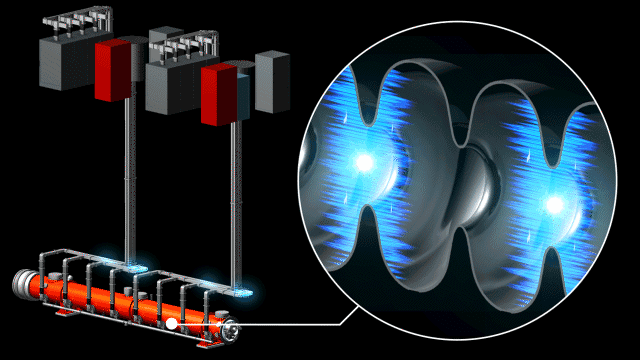stand
Editor’s note: Below is a press release from the University of Chicago announcing an exciting new result from the Event Horizon Telescope (EHT), an array of radio telescopes located around the world. Included in that array is the South Pole Telescope (SPT), which is operated by a collaboration of more than 80 scientists and engineers from a group of universities and U.S. Department of Energy national laboratories, including three institutions in the Chicago area.
These research organizations — the University of Chicago and the U.S. Department of Energy’s Fermi National Accelerator Laboratory and Argonne National Laboratory — worked together to build an ultrasensitive camera for the telescope, called SPT-3G, which contains 16,000 superconducting detectors. Exploiting the technical capability and expertise of its Silicon Detector Facility, Fermilab led the assembly of the detector modules and their integration into the SPT-3G camera, which was designed by Bradford Benson of Fermilab and the University of Chicago. On EHT, Fermilab scientists helped to design the EHT receiver interface and installation on the SPT and have supported EHT observations through their leading roles on SPT-3G survey and SPT telescope operations. Fermilab’s work on the South Pole Telescope is funded by the U.S. Department of Energy Office of Science.
Astronomers have unveiled the first image of the supermassive black hole at the center of our own Milky Way galaxy. This result provides overwhelming evidence that the object is indeed a black hole and yields valuable clues about the workings of such giants, which are thought to reside at the center of most galaxies.
The image was produced by a global research team called the Event Horizon Telescope Collaboration, using observations from a worldwide network of radio telescopes including the University of Chicago-affiliated South Pole Telescope.

First image of the black hole at the center of the Milky Way. This is the first image of Sagittarius A* (or Sgr A* for short), the supermassive black hole at the center of our galaxy. It’s the first direct visual evidence of the presence of this black hole. It was captured by the Event Horizon Telescope, an array which linked together eight existing radio observatories across the planet to form a single “Earth-sized” virtual telescope. The telescope is named after the “event horizon”, the boundary of the black hole beyond which no light can escape. Although we cannot see the event horizon itself, because it cannot emit light, glowing gas orbiting around the black hole reveals a telltale signature: a dark central region (called a “shadow”) surrounded by a bright ring-like structure. The new view captures light bent by the powerful gravity of the black hole, which is four million times more massive than our Sun. The image of the Sgr A* black hole is an average of the different images the EHT Collaboration has extracted from its 2017 observations. Photo: Event Horizon Telescope Collaboration
The image is a long-anticipated look at the massive object that sits at the very center of our galaxy. Scientists had previously seen stars orbiting around something invisible, compact, and very massive at the center of the Milky Way. This strongly suggested that this object — known as Sagittarius A* — is a black hole, and today’s image provides the first direct visual evidence of it.
Although we cannot see the black hole itself, because it is completely dark, glowing gas around it reveals a telltale signature: a dark central region (called a “shadow”) surrounded by a bright ring-like structure. The new view captures light bent by the powerful gravity of the black hole, which is four million times more massive than our Sun.
“We were stunned by how well the size of the ring agreed with predictions from Einstein’s Theory of General Relativity,” said Event Horizon Telescope Project Scientist Geoffrey Bower from the Institute of Astronomy and Astrophysics, Academia Sinica, Taipei. “These unprecedented observations have greatly improved our understanding of what happens at the very center of our galaxy, and offer new insights on how these giant black holes interact with their surroundings.”
The results are being published today in a special issue of The Astrophysical Journal Letters.
Because the black hole is about 27,000 light-years away from Earth, it appears to us to have about the same size in the sky as a donut on the Moon. To image it, the team created the powerful Event Horizon Telescope, which linked together eight existing radio observatories across the planet to form a single “Earth-sized” virtual telescope.
The Event Horizon Telescope observed Sagittarius A* (known for short as Sgr A*, pronounced “sadge-ay-star”) on multiple nights, collecting data for many hours in a row, similar to using a long exposure time on a camera.
One of these telescopes was the South Pole Telescope, operated by an international collaboration led by the University of Chicago and located at NSF’s Amundsen-Scott South Pole Station. Its unique remote geographic location at the South Pole provides the Event Horizon Telescope its highest-resolution information and a 24-hour-a-day view of the galactic center.
Even though the South Pole Telescope is used primarily for a different scientific goal – it is one of the most sensitive instruments in the world built to measure the light left over from the Big Bang – its crew jumped at the chance to be part of the Event Horizon Telescope collaboration.
“Scientists have been investigating the object at the center of our galaxy since I was a student decades ago, and it is exciting to be part of an experiment that can definitively image the black hole that we know must be there,” said University of Chicago Prof. John Carlstrom, who directs the South Pole Telescope team. “These observations give us an unprecedented view of gravity in one of the most extreme environments in our universe. It’s very cool to have this remarkable image where we can see the shadow of the black hole.”
The breakthrough follows the Event Horizon Telescope collaboration’s 2019 release of the first image of a black hole, called M87*, at the center of the more distant Messier 87 galaxy. The two black holes look remarkably similar, even though our galaxy’s black hole is more than a thousand times smaller and less massive than M87*.
“We have two completely different types of galaxies and two very different black hole masses, but close to the edge of these black holes they look amazingly similar,” said Sera Markoff, co-chair of the Event Horizon Telescope Science Council and a professor of theoretical astrophysics at the University of Amsterdam, the Netherlands. “This tells us that General Relativity governs these objects up close, and any differences we see further away must be due to differences in the material that surrounds the black holes.”
This achievement was considerably more difficult than for M87*, even though Sgr A* is much closer to us.
“The gas in the vicinity of the black holes moves at the same speed — nearly as fast as light — around both Sgr A* and M87*. But where gas takes days to weeks to orbit the larger M87*, in the much smaller Sgr A* it completes an orbit in mere minutes,” Event Horizon Telescope scientist Chi-kwan (‘CK’) Chan, from Steward Observatory and Department of Astronomy and the Data Science Institute of the University of Arizona, explained.
“This means the brightness and pattern of the gas around Sgr A* was changing rapidly as the Event Horizon Telescope Collaboration was observing it — a bit like trying to take a clear picture of a puppy quickly chasing its tail.”
The researchers had to develop sophisticated new tools that accounted for the gas movement around Sgr A*. While M87* was an easier, steadier target, with nearly all images looking the same, that was not the case for Sgr A*. The image of the Sgr A* black hole is an average of the different images the team extracted, finally revealing the giant lurking at the center of our galaxy for the first time.
The effort was made possible through the ingenuity of more than 300 researchers from 80 institutes around the world that together make up the Event Horizon Telescope Collaboration. In addition to developing complex tools to overcome the challenges of imaging Sgr A*, the team worked rigorously for five years, using supercomputers to combine and analyse their data, all while compiling an unprecedented library of simulated black holes to compare with the observations.
Even just getting all the data to the collaboration to analyse was a logistical challenge, especially for the South Pole Telescope. Its remote location gives it an excellent view of SgrA*, but the enormous amount of data it gathers is too large to send by the limited internet available at the South Pole. The data had to be collected on discs and flown out by plane—which can only happen during the Antarctic summer, between November and February, when the weather is safe enough to fly.
Scientists are particularly excited to finally have images of two black holes of very different sizes, which offers the opportunity to understand how they compare and contrast. They have also begun to use the new data to test theories and models of how gas behaves around supermassive black holes. This process is not yet fully understood but is thought to play a key role in shaping the formation and evolution of galaxies.
“Now we can study the differences between these two supermassive black holes to gain valuable new clues about how this important process works,” said Event Horizon Telescope scientist Keiichi Asada from the Institute of Astronomy and Astrophysics, Academia Sinica, Taipei. “We have images for two black holes — one at the large end and one at the small end of supermassive black holes in the Universe — so we can go a lot further in testing how gravity behaves in these extreme environments than ever before.”
Progress on the Event Horizon Telescope continues: a major observation campaign in March 2022 included more telescopes than ever before. The ongoing expansion of the Event Horizon Telescope network and significant technological upgrades will allow scientists to share even more impressive images as well as movies of black holes in the near future.
The South Pole Telescope collaboration is led by the University of Chicago and includes research groups at over a dozen institutions, including the UChicago-affiliated Argonne and Fermi national laboratories. Specialized Event Horizon Telescope instrumentation was provided by the University of Arizona. The participation of the South Pole Telescope in the Event Horizon Telescope is funded primarily by the National Science Foundation.
Editor’s note: This press release was originally published by SLAC National Accelerator Laboratory.
The U.S. Department of Energy’s Fermi National Accelerator Laboratory designed, built and tested 18 of the 37 cryogenic accelerator modules that are installed in the LCLS-II linac. In total for LCLS-II, 41 modules were delivered to SLAC of which Fermilab supplied 20 modules, including spares, and Jefferson Lab, a key partner in this project, supplied the remainder. The performance of these modules on the test stand dramatically exceeded the then state of the art and set the stage for an additional upgrade (LCLS-II HE) and for future CW FELs.
Nestled 30 feet underground in Menlo Park, California, a half-mile-long stretch of tunnel is now colder than most of the universe. It houses a new superconducting particle accelerator, part of an upgrade project to the Linac Coherent Light Source (LCLS) X-ray free-electron laser at the Department of Energy’s SLAC National Accelerator Laboratory.
Crews have successfully cooled the accelerator to minus 456 degrees Fahrenheit – or 2 kelvins – a temperature at which it becomes superconducting and can boost electrons to high energies with nearly zero energy lost in the process. It is one of the last milestones before LCLS-II will produce X-ray pulses that are 10,000 times brighter, on average, than those of LCLS and that arrive up to a million times per second – a world record for today’s most powerful X-ray light sources.

A half-mile-long stretch of tunnel in Menlo Park, California is now colder than most of the universe. It houses a new superconducting particle accelerator, part of an upgrade project to the Linac Coherent Light Source (LCLS) X-ray free-electron laser. Photo: Jim Gensheimer/Greg Stewart, SLAC
“In just a few hours, LCLS-II will produce more X-ray pulses than the current laser has generated in its entire lifetime,” said Mike Dunne, director of LCLS. “Data that once might have taken months to collect could be produced in minutes. It will take X-ray science to the next level, paving the way for a whole new range of studies and advancing our ability to develop revolutionary technologies to address some of the most profound challenges facing our society.”
With these new capabilities, scientists can examine the details of complex materials with unprecedented resolution to drive new forms of computing and communications; reveal rare and fleeting chemical events to teach us how to create more sustainable industries and clean energy technologies; study how biological molecules carry out life’s functions to develop new types of pharmaceuticals; and peek into the bizarre world of quantum mechanics by directly measuring the motions of individual atoms.
A chilling feat
LCLS, the world’s first hard X-ray free-electron laser (XFEL), produced its first light in April 2009, generating X-ray pulses a billion times brighter than anything that had come before. It accelerates electrons through a copper pipe at room temperature, which limits its rate to 120 X-ray pulses per second.
In 2013, SLAC launched the LCLS-II upgrade project to boost that rate to a million pulses and make the X-ray laser thousands of times more powerful. For that to happen, crews removed part of the old copper accelerator and installed a series of 37 cryogenic accelerator modules, which house pearl-like strings of niobium metal cavities. These are surrounded by three nested layers of cooling equipment, and each successive layer lowers the temperature until it reaches nearly absolute zero – a condition at which the niobium cavities become superconducting.
“Unlike the copper accelerator powering LCLS, which operates at ambient temperature, the LCLS-II superconducting accelerator operates at 2 kelvins, only about 4 degrees Fahrenheit above absolute zero, the lowest possible temperature,” said Eric Fauve, the Cryogenic Division director at SLAC. “To reach this temperature, the linac is equipped with two world-class helium cryoplants, making SLAC one of the significant cryogenic landmarks in the U.S. and on the globe. The SLAC Cryogenics team has worked on site throughout the pandemic to install and commission the cryogenic system and cool down the accelerator in record time.”
One of these cryoplants, built specifically for LCLS-II, cools helium gas from room temperature all the way down to its liquid phase at just a few degrees above absolute zero, providing the coolant for the accelerator.
On April 15, the new accelerator reached its final temperature of 2 K for the first time, and today, May 9, is stable in its final configuration.

The linac is equipped with two world-class helium cryoplants. One of these cryoplants, built specifically for LCLS-II, cools helium gas from room temperature all the way down to its liquid phase at just a few degrees above absolute zero, providing the coolant for the accelerator. Photo: Greg Stewart, SLAC
“The cooldown was a critical process and had to be done very carefully to avoid damaging the cryomodules,” said Andrew Burrill, director of SLAC’s Accelerator Directorate. “We’re excited that we’ve reached this milestone and can now focus on turning on the X-ray laser.”
Bringing it to life
In addition to a new accelerator and a cryoplant, the project required other cutting-edge components, including a new electron source and two new strings of undulator magnets that can generate both “hard” and “soft” X-rays. Hard X-rays, which are more energetic, allow researchers to image materials and biological systems at the atomic level. Soft X-rays can capture how energy flows between atoms and molecules, tracking chemistry in acton and offering insights into new energy technologies. To bring this project to life, SLAC teamed up with four other national labs – Argonne, Berkeley Lab, Fermilab and Jefferson Lab – and Cornell University.
Jefferson Lab, Fermilab and SLAC pooled their expertise for research and development on cryomodules. After constructing the cryomodules, Fermilab and Jefferson Lab tested each one extensively before the vessels were packed and shipped to SLAC by truck. The Jefferson Lab team also designed and helped procure the elements of the cryoplants.
“The LCLS-II project required years of effort from large teams of technicians, engineers and scientists from five different DOE laboratories across the U.S. and many colleagues from around the world,” said Norbert Holtkamp, SLAC deputy director and the project director for LCLS-II. “We couldn’t have made it to where we are now without these ongoing partnerships and the expertise and commitment of our collaborators.”
Toward first X-rays
Now that the cavities have been cooled, the next step is to pump them with more than a megawatt of microwave power to accelerate the electron beam from the new source. Electrons passing through the cavities will draw energy from the microwaves so that by the time the electrons have passed through all 37 cryomodules, they’ll be moving close to the speed of light. Then they’ll be directed through the undulators, forcing the electron beam on a zigzag path. If everything is aligned just right – to within a fraction of the width of a human hair – the electrons will emit the world’s most powerful bursts of X-rays.
This is the same process that LCLS uses to generate X-rays. However, since LCLS-II uses superconducting cavities instead of warm copper cavities based on 60-year-old technology, it can can deliver up to a million pulses per second, 10,000 times the number of X-ray pulses for the same power bill.

Now that the cavities have been cooled, the next step is to pump them with more than a megawatt of microwave power to accelerate the electron beam from the new source. Electrons passing through the cavities will draw energy from the microwaves so that by the time the electrons have passed through all 37 cryomodules, they’ll be moving close to the speed of light. Photo: Greg Stewart, SLAC
Once LCLS-II produces its first X-rays, which is expected to happen later this year, both X-ray lasers will work in parallel, allowing researchers to conduct experiments over a wider energy range, capture detailed snapshots of ultrafast processes, probe delicate samples and gather more data in less time, increasing the number of experiments that can be performed. It will greatly expand the scientific reach of the facility, allowing scientists from across the nation and around the world to pursue the most compelling research ideas.
This project is supported by DOE’s Office of Science. LCLS is a DOE Office of Science user facility.
